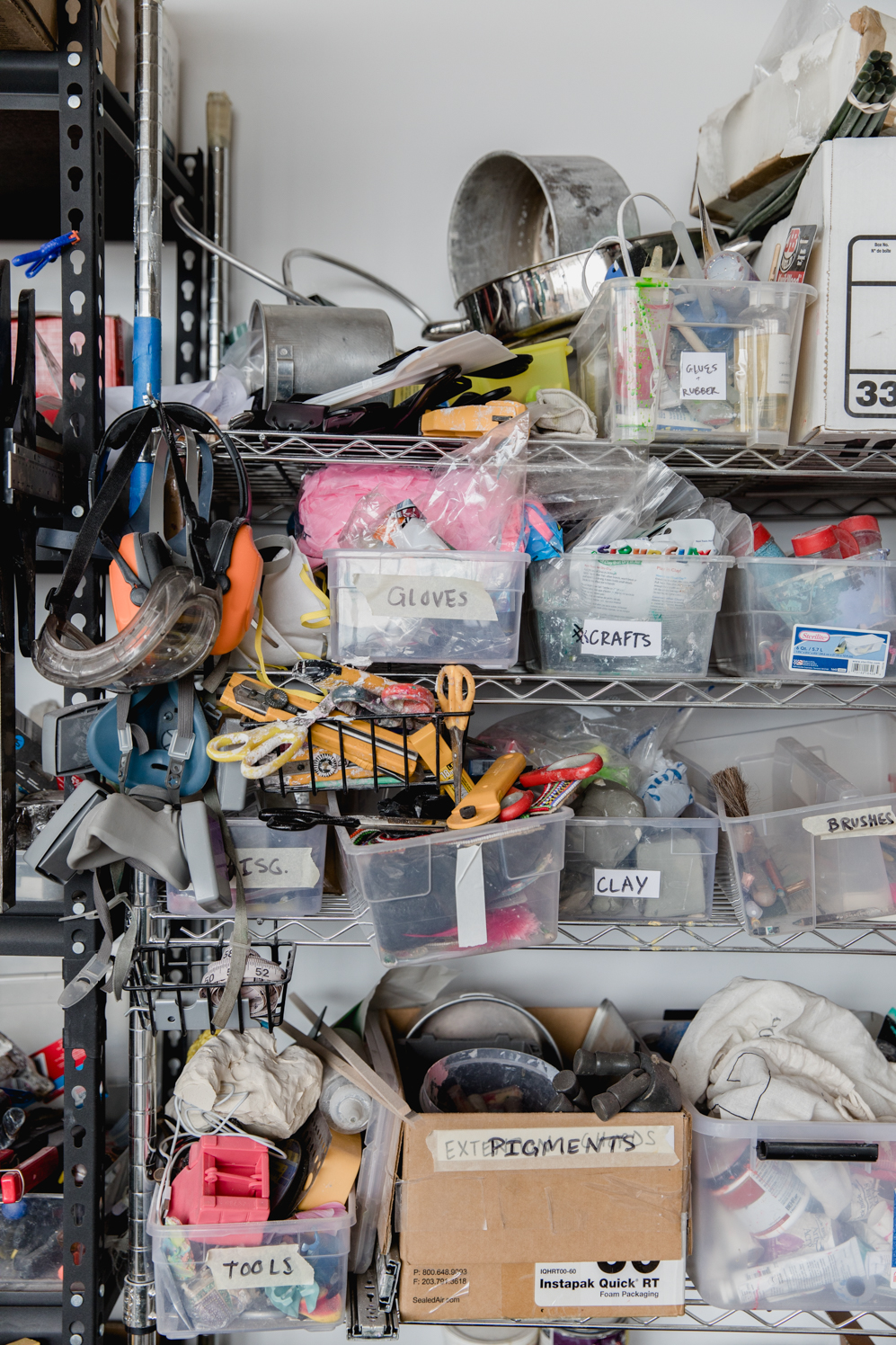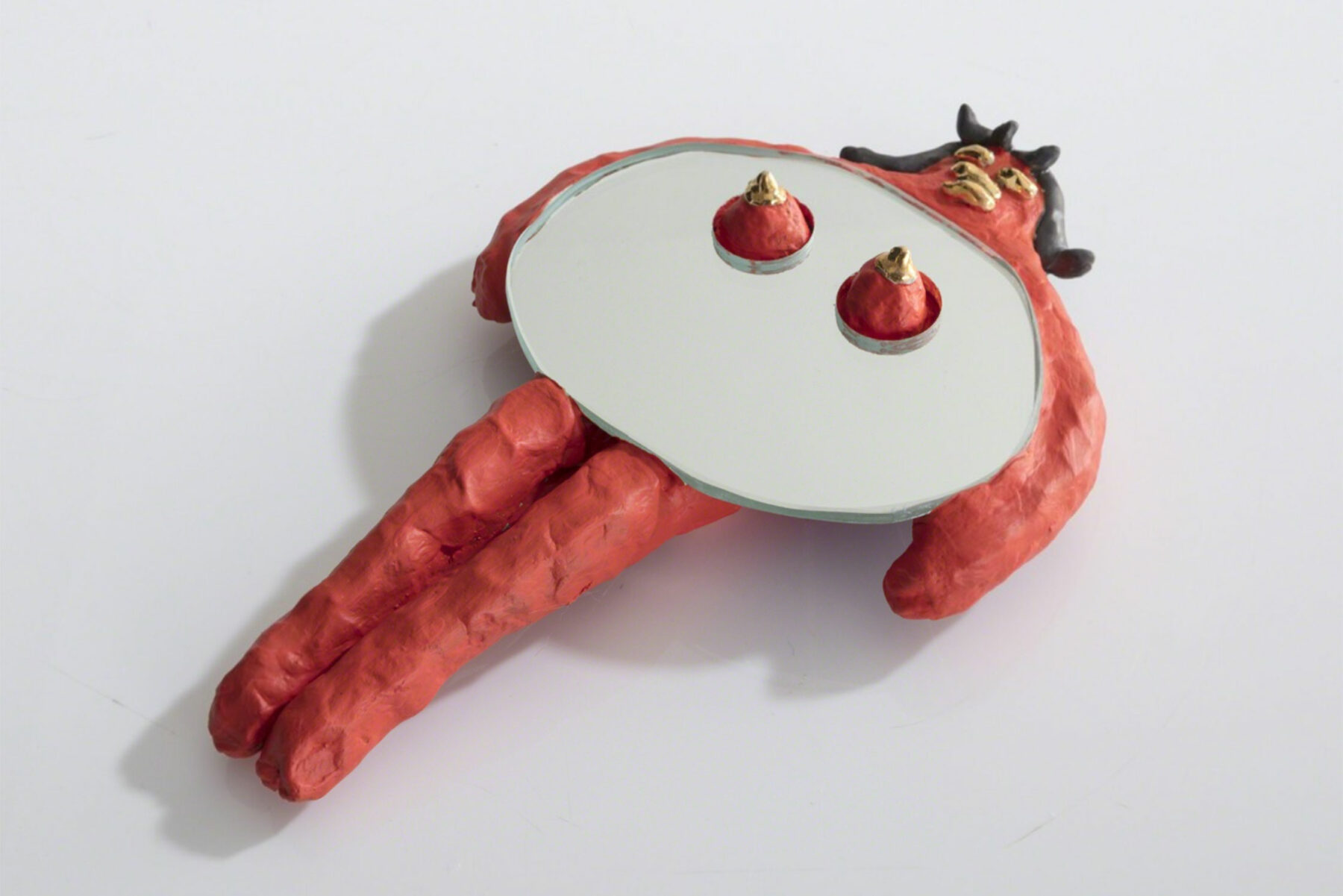Unabashedly frank, with a comical flare and a fervor for the female form, Katie Stout’s work transcends both traditional home furnishings and sculptural work alike.
In a vast warehouse in the Bed-Stuy neighborhood of Brooklyn, Katie crafts couches out of various textiles and her signature lady lamps out of clay, celebrating womanhood with colors and textures in the form of functional pieces.
Katie’s creative process is bold, experimental, and constantly evolving—during our studio visit she was feverishly finding a way to support a desk she was assembling out of papier-mâché and wire for an upcoming show. Katie’s work can be intimidating because of its sheer boldness, but when you strip it down, it’s a reflection of the woman behind the work: engaging, approachable, confident, and fun.
In her corner studio on the sixth floor with a wall of windows overlooking much of Brooklyn, Katie and her two assistants work on a variety of ongoing projects. “I want to take a more humanistic approach to art and art making, one where it can be touched and used, and provides a different and more welcoming approach to how it’s viewed and how it functions.” When asked about the sexual nature of her work, Katie responds by saying the pieces, “defy traditional categories of what women are supposed to be by being domestic and choosing to be sexually open. Don’t call it naughty.”


“My education gave me the tools to know which rules to break. It’s like what John Waters said, ‘In order to have bad taste you must first have very good taste.’”
Katie Stout
-
What type of work do you create and what kind of mediums do you use?
I make art that functions as furniture but sometimes it doesn’t. I’m not totally committed to any material; I use scraps around my studio, a lot of clay, and I love papier-mâché. I tend to take any opportunity to work with a new material. I like using everything and learning about different processes and then doing things the wrong way. Love easy low-brow materials like crayons, trash, things like clay that can be mushed.
-
How did your childhood influence your creativity? Did you grow up in a creative environment? And did you always want to be an artist?
I grew up in a household where creativity was celebrated. I had a whole zone to myself where I could make a mess and there was never a shortage of art supplies. My mom also went to RISD and her mother had been a photographer. When I wanted to be a cheerleader in 4th grade, my dad said, “No, you’re going to be cheered for.” Might be the coolest thing he’s ever said.
-
What is your earliest memory of art, or creating? What certain experiences influenced your creativity and awareness?
My earliest memory is drawing an egg person with stick limbs—I believe it’s a popular childhood motif. Even though my parents were supportive, there were a few traumatic domestic experiences that I deal with by making domestic objects that reject traditional notions of domesticity and what it means to be “good.” I think “good girl” is a toxic phrase.
-
You mentioned you lost your mother not too long ago, and that one of the things you love about art is being able to work through and process life when creating. How is this reflected in your work?
I make work that reenvisions what a home can be, or rather doesn’t try to be perfect. A lot of it uses humor, because: A) it keeps me interested, and, B) its necessary in order to get through shit situations.


Katie’s studio overlooks much of Brooklyn with views of the Manhattan skyline.
-
You went to RISD for furniture design which seems so practical and functional, yet you have managed to take that foundation and build upon it to create pieces both functional and completely visually unique. How much of your education comes into play when you work now?
I think you need to know how to do something in order to really do it wrong and break the rules. My education gave me the tools to know which rules to break. It’s like what John Waters said, “In order to have bad taste you must first have very good taste.”
-
Your furniture is designed to not only be art, but also to be used as actual furniture in a household. Do you find people treat it as both after purchasing a piece, or do they covet it more like a piece of art not to be touched?
I think people are sometimes confused about how they’re supposed to use it. It’s a space that people feel uncomfortable in, which I love. But I think you can spill milk on something and still treat it like a piece of art. I guess art is defined by the viewer. In general I think people revere prescribed art too much and lesser known art too little. Someone spending $450 million on a painting is gross. Especially if it’s da Vinci. I couldn’t get out of the da Vinci show at the Met fast enough because the hype eclipsed the merits of the work.
I want to take a more humanistic approach to art and art making, one where it can be touched and used and provides a different and more welcoming approach to how it’s viewed and how it functions.
-
What is it like to be an artist in Brooklyn? Is it easy to fall into a creative community there that motivates and inspires you?
I graduated from RISD in 2012 and immediately moved to Brooklyn. A lot of my friends from RISD also moved to Brooklyn, so I immediately had a creative community and I’ve met lots of new people by participating in the art and design world. It’s been amazing growing up together and watching everyone succeed in their own ways.
-
Tell us about your studio space.
I found the space through a friend who had a studio space there before. But I have to move in six months, which I can’t even think about because it’s so hard to find space in Brooklyn. It’s so expensive! In order to find a space you have to just really spread your feelers and ask everyone. The space is in a large, bizarre building on the corner of Nostrand and Park in Bed Stuy. It is half Hasidic businesses and half artist studios. I’ve been there for two years but will get lost if I venture anywhere beyond the 1st or 6th floor where my studio is located. I rent a corner of the space out to a ceramicist and have two assistants, so it’s always a bustle. Even though it’s on the 6th floor, the traffic is super audible from the corner of windows. When it’s windy the windows visibly rattle, it creates the feeling of impending chaos that I imagine one feels on a ship before a storm. There’s something reassuring about how off-putting the whole experience can be, like if I get lost I know it’s only temporary and I know the windows won’t just break into a million pieces even though it sounds like they will. Also, I leave a lot of crap around my studio because I never know what I might need.




-
You explore themes around sexuality in your work. Is this a particular statement?
I was interested in exploring the objectification of women by of extreme objectification. There’s a frenzy of conversation about sexual abuse in the media with #metoo, Hollywood, US gymnastics, Donald Trump. Women have inarguably been treated as objects to be used. By parodying the art objects of women, the ladies I create own their bodies. I imagine them holding the lampshade up as a choice they’ve made. They defy traditional categories of what women are supposed to be by being domestic and choosing to be sexually open. Don’t call it naughty.
-
How did your idea of the folding chairs come about? They have been very popular!
The folding chairs came about because I had made a stuffed animal chair that I thought of as an apathetic chair that just wanted to lounge around. I thought it would be cool to subvert that idea and make a stuffed chair that kind of looked as if it wouldn’t support a person but actually could.
-
What is your favorite piece you’ve ever created?
My favorite piece has been Wench Bench due partially to the unexpected and automatic nature of its actualization. I had a chainsaw artist in Duluth carve nude female forms out of pine stumps. The nude ladies were various apathetic positions lying on the floor—in fetal position after having given up—and I had them carved out of stumps into little stools. But the carvings came back much smaller than I expected and were too low to sit on. So I puzzle-pieced them all together into a bench, which I called Wench Bench, which made for a far more dynamic piece than my original idea. I like working with mistakes and chance, and being open to shifting ideas. I think there’s also something poetic about originally wanting to make separate pieces about female fatigue and then ultimately making one about strength in numbers.
“I want to take a more humanistic approach to art and art making, one where it can be touched and used and provides a different and more welcoming approach.”
Katie Stout
-
Anything exciting you’re currently working on?
Right now I’m working on some large, shady lady lamps, they are uncannily human in scale. I make them out of clay and epoxy putty since my kiln isn’t large enough to fire them as one piece. These each take about a month to make because the clay takes a long to dry before it can be fired in the kiln.
-
What do you listen to while you work?
I listen to a variety of things when I work. I have two amazing assistants and most of the time I just ask them to put something on because I just don’t really want to think about it. I rarely pay attention to what’s playing, so if it’s not music, anthologies are the best. David Sedaris’ Theft by Finding: Diaries 1977-2002 have been great because you can dip in and out and still understand what’s going on. I tried listening to Astrophysics for People in a Hurry by Neil deGrasse Tyson but I quickly learned that “people in a hurry” doesn’t mean “people who are half listening”.” In terms of music, I like a mix of folk and pop but it’s really all over the place: Ardous Harding, Donnie & Joe Emerson, Fleetwood Mac, Lil Peep, Offspring, Carly Rae Jepson.
-
What is the best thing you’ve done for your career?
The best thing I’ve done is pursue it full-time and not really listen to people who thought I was insane.



More information on Katie Stout’s body of work can be found at New York Gallery R & Company. Find more of her lamps, rugs, stuffed chairs and paper pulp works on her website. Read about her Art Basel Miami show of papier-mâché pieces that explored the female body over on the Nina Johnson Gallery website.
For more portraits in Brooklyn see all of our New York stories.
Text & Photography: Erin Little for FvF Productions








